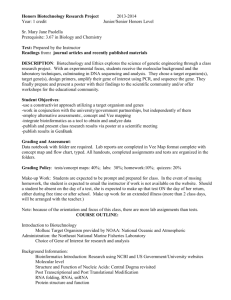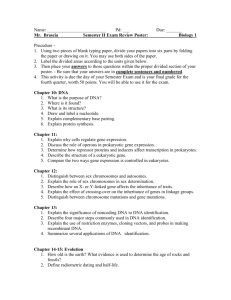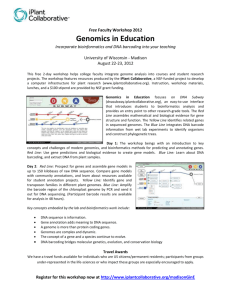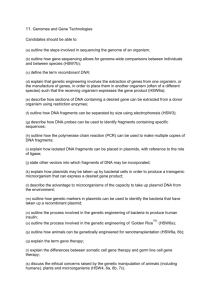Harvard Summer Program Immunology Project Resource
advertisement
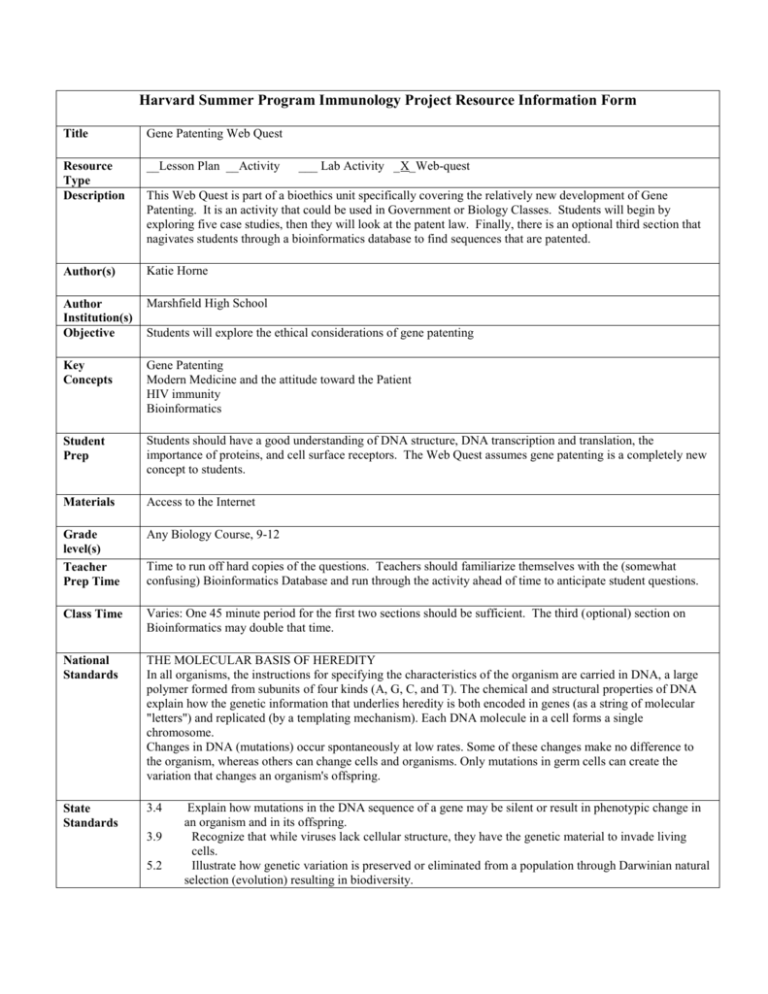
Harvard Summer Program Immunology Project Resource Information Form Title Gene Patenting Web Quest Resource Type Description __Lesson Plan __Activity Author(s) Katie Horne Author Institution(s) Objective Marshfield High School Key Concepts Gene Patenting Modern Medicine and the attitude toward the Patient HIV immunity Bioinformatics Student Prep Students should have a good understanding of DNA structure, DNA transcription and translation, the importance of proteins, and cell surface receptors. The Web Quest assumes gene patenting is a completely new concept to students. Materials Access to the Internet Grade level(s) Teacher Prep Time Any Biology Course, 9-12 Class Time Varies: One 45 minute period for the first two sections should be sufficient. The third (optional) section on Bioinformatics may double that time. National Standards THE MOLECULAR BASIS OF HEREDITY In all organisms, the instructions for specifying the characteristics of the organism are carried in DNA, a large polymer formed from subunits of four kinds (A, G, C, and T). The chemical and structural properties of DNA explain how the genetic information that underlies heredity is both encoded in genes (as a string of molecular "letters") and replicated (by a templating mechanism). Each DNA molecule in a cell forms a single chromosome. Changes in DNA (mutations) occur spontaneously at low rates. Some of these changes make no difference to the organism, whereas others can change cells and organisms. Only mutations in germ cells can create the variation that changes an organism's offspring. State Standards 3.4 ___ Lab Activity _X_Web-quest This Web Quest is part of a bioethics unit specifically covering the relatively new development of Gene Patenting. It is an activity that could be used in Government or Biology Classes. Students will begin by exploring five case studies, then they will look at the patent law. Finally, there is an optional third section that nagivates students through a bioinformatics database to find sequences that are patented. Students will explore the ethical considerations of gene patenting Time to run off hard copies of the questions. Teachers should familiarize themselves with the (somewhat confusing) Bioinformatics Database and run through the activity ahead of time to anticipate student questions. 3.9 5.2 Explain how mutations in the DNA sequence of a gene may be silent or result in phenotypic change in an organism and in its offspring. Recognize that while viruses lack cellular structure, they have the genetic material to invade living cells. Illustrate how genetic variation is preserved or eliminated from a population through Darwinian natural selection (evolution) resulting in biodiversity. Sources Dave Form, Minuteman Regional High School: Analysis of a Mutation that Confers Resistance to Infection with HIV (2003) References http://biotech.law.lsu.edu/cases/consent/Moore_v_Regents.htm http://dnapatents.georgetown.edu/ostext/5679635.htm http://dnapatents.georgetown.edu/ostext/5753441.htm http://jncicancerspectrum.oupjournals.org/cgi/content/full/jnci;92/8/596 http://online.sfsu.edu/~rone/GEessays/WhoOwnsYourGenes.html http://www.ncbi.nlm.nih.gov/ http://www.ncbi.nlm.nih.gov/About/primer/bioinformatics.html http://www.ncbi.nlm.nih.gov/entrez/query.fcgi?cmd=Retrieve&db=pubmed&dopt=Abstract&list_uids=8751444 http://www.nsgc.org/newsroom/position_dna.asp http://www.ornl.gov/TechResources/Human_Genome/elsi/patents.html http://www.pbs.org/wnet/secrets/case_plague/interview.html Assessment This WebQuest includes an answer key. The questions can be graded accordingly. There are suggestions in the “teacher resources” section for additional projects and presentations.


